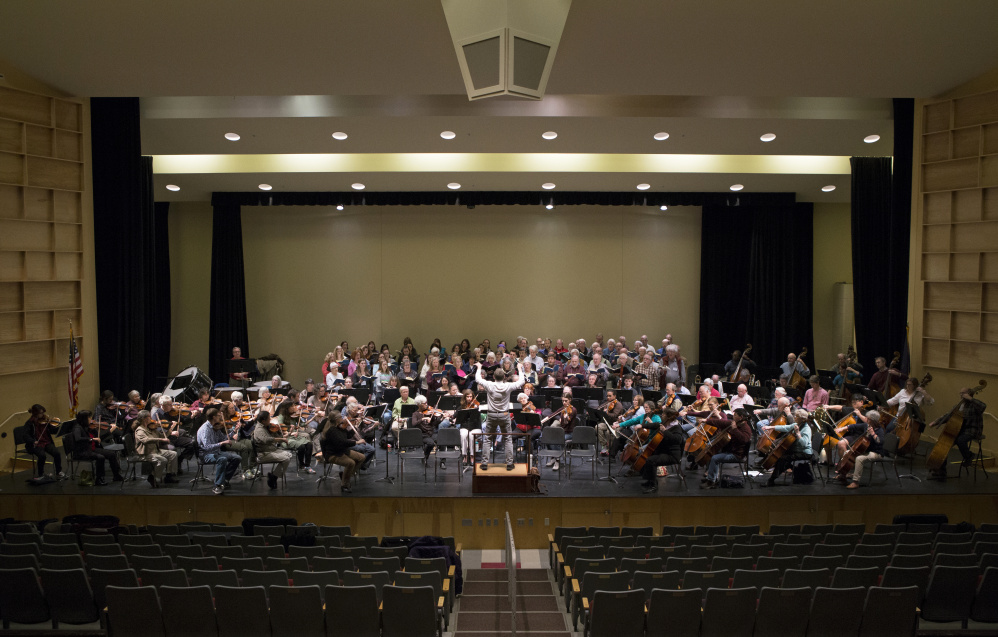The Midcoast Symphony Orchestra presented four ambitious and varied programs this season, and for the last of them, Rohan Smith, the orchestra’s music director, pulled out all the stops: Joining forces with the Vox Nova Chamber Choir, the Oratorio Chorale and a balanced quartet of vocal soloists, Smith assembled an ensemble of about 160 players and singers for performances of Giuseppe Verdi’s spectacularly operatic Messa da Requiem at the Franco Center in Lewiston, on Saturday evening, and the Orion Performing Arts Center in Topsham, on Sunday afternoon.
It was a brave move. Verdi completed the Requiem late in his career, when his orchestral scoring was as exacting and evocative as his vocal writing. No opportunity for striking effects is left unexplored. In his setting of the Tuba Mirum, in which souls are summoned to the throne of God, he has trumpets stationed around the hall, surrounding the audience and enveloping it in antiphonal sound. Where most Mass composers set the Dies Irae once and move on, Verdi makes it a recurring theme, and provides a far more terrifying musical description of the “day of wrath” than any other composer has devised, couched as it is in fortissimo, chromatically descending choral figures, supported by a churning orchestra and punctuated by steady thwacking on both timpani and bass drum.
But it is also a work of tremendous extremes. Just after we hear the Dies Irae for the last time, in the work’s closing Libera Me section, Verdi returns to the opening text, the Requiem Aeternam, presented here as a ravishing soprano solo with a hushed, almost ghostly, a cappella choral accompaniment. Throughout the piece, loud dramatic passages give way to gentle responses, and operatic solo vocal writing gives way to purely liturgical figures.
All that is a lot to expect of a full-time professional orchestra and chorus, let alone community ensembles that perform a handful of programs every season. At the Sunday afternoon performance, Smith and his combined forces produced a performance of impressive heft and fluidity, and maintained their focus and stamina through much of the nearly 90-minute score. It was only during the final half hour that its energy began to flag, leading to attacks that were not quite unified, intonation mishaps and strident string playing.
But for all that, you could not say that Verdi – or the large audience on hand to hear his Requiem – was shortchanged. Smith led a comfortably paced performance that conveyed the essentials of this great work’s spirit, as well as much of its drama and depth. The combined choirs produced a lush, blended sound, as well as agile counterpoint, particularly in the Sanctus (an eight-part choral fugue) and the Libera Me, and they were as adept at suggesting the brimstone of the Dies Irae as the heavenly serenity of Verdi’s gentler music.
The soloists’ contributions were also variable, but grew stronger as the work unfolded. Soprano Rachele Schmiege and mezzo-soprano Rebecca Ringle were the most consistent of the four, with Schmiege bringing an illuminating, velvet tone to the soaring line of that revisited Requiem Aeternam, and Ringle bringing a lovely tone and graceful phrasing to her solo line in the Lacrymosa.
Verdi gave the biggest star turn – the Ingemisco – to the tenor, and if Kevin Ray sounded strained at first, he quickly warmed to the task and gave a performance in which drama and lyricism were pleasingly balanced. And if Gustav Andreassen’s bass often sounded lighter than you generally want in Verdi, his phrasing suited the text, and he shone – as did all the soloists – in the ensembles.
Allan Kozinn is a former music critic and culture writer for The New York Times who lives in Portland. He can be contacted at:
allankozinn@gmail.com
Twitter: kozinn
Send questions/comments to the editors.



Comments are no longer available on this story